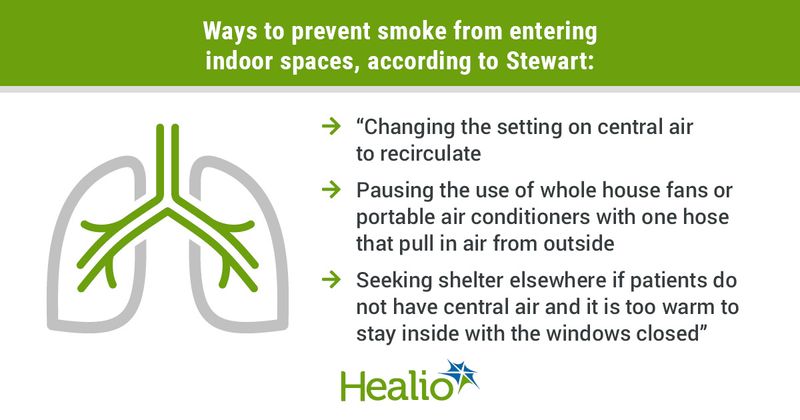Q&A: Protecting patients with respiratory diseases during wildfire outbreak
People residing in the East Coast are currently experiencing poor air quality due to smoke and haze from hundreds of wildfires in Canada.
With this wildfire smoke in the air, patients with various respiratory diseases, such as asthma, COPD and pulmonary fibrosis, are at risk for worse symptoms of their condition, Bev Stewart, national senior director of lung disease programs at the American Lung Association, told Healio. It is crucial that respiratory specialists know how to guide their patients during this outbreak.

Healio spoke with Stewart to learn more about how pollution from wildfires impacts patients with respiratory diseases and how individuals in areas with poor air quality can protect themselves and prevent smoke from entering their homes.
Healio: Could you summarize the current wildfire outbreak?
Stewart: Wildfires in Canada are causing harmful levels of particle pollution in multiple U.S. states, including “unhealthy,” “very unhealthy” and even “hazardous” levels according to the Air Quality Index. People can and should take steps to protect their health.
Healio: What different types of pollution are being released into the atmosphere with these fires?
Stewart: The main worry with wildfires is fine particulate matter. These fine particles are a mix of substances, and what makes them dangerous is their size — they’re small enough to penetrate deep in the lungs, past the body’s natural defenses and can even pass into the bloodstream.
Healio: What effect can this pollution have on an individual’s health?
Stewart: Symptoms of smoke exposure vary from person to person, but generally speaking, individuals may experience coughing, runny nose, fast heartbeat, fatigue, headaches, stinging or watering eyes, wheezing, scratchy throat, shortness of breath and/or a worsening of respiratory diseases such as asthma or COPD. To reduce exposure, follow local guidance, typically remaining indoors as much as possible, to minimize exposure. If you think you will need to be outside during the smoke exposure, consider getting a disposable respiratory mask that is rated as N95 or higher to help reduce inhalation of particle pollution. The masks must fit securely to work, and do not work on children or people with beards as they can’t form a protective seal.
Healio: What particular effects does this pollution have on people with respiratory diseases, such as COPD, pulmonary fibrosis and lung cancer?
Stewart: Smoke exposure can worsen symptoms of respiratory diseases such as COPD or pulmonary fibrosis. These worsening of symptoms may require medical intervention so it is important for everyone, but especially those living with chronic conditions that worsen with exposure to wildfire smoke, to pay close attention to their symptoms and communicate changes in symptoms that may require changes in treatment with their health care provider.
Healio: What do respiratory specialists need to know in order to guide their patients through this outbreak?
Stewart: Children, older adults and people with chronic lung or heart disease, or diabetes are more at risk for adverse effects from wildfire smoke, but anyone can experience symptoms that require medical attention. Individuals who work outdoors or must spend time outdoors are also more likely to be impacted by the smoke. There are steps that can be taken to reduce the amount of smoke being pulled indoors — such as changing the setting on central air to recirculate, pausing the use of whole house fans or portable air conditioners with one hose that pull in air from outside and seeking shelter elsewhere if patients do not have central air and it is too warm to stay inside with the windows closed. The American Lung Association’s Lung HelpLine is available to answer questions about wildfire smoke exposure from respiratory specialists or the general public and can be contacted at 800-LUNGUSA.

